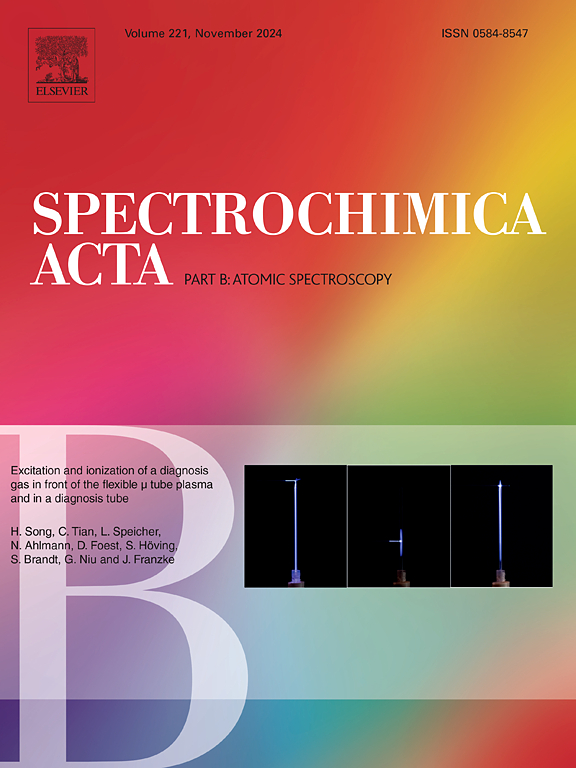Photon counting with intensified charge coupled device (ICCD) – II. Laser induced breakdown spectroscopy (LIBS) spectral measurement
IF 3.8
2区 化学
Q1 SPECTROSCOPY
引用次数: 0
Abstract
This study explores the application of photon counting (PC) to enhance the resolution of spectra acquired by an intensified charge-coupled device (ICCD) detector, with a focus on analytical atomic emission spectrometry using laser-induced breakdown spectroscopy (LIBS) as a use-case example. It demonstrates that, for spectra obtained with the same spectrometer–ICCD system, PC provides higher spectral resolution compared to conventional analog detector readout. This enhancement is particularly evident in the line wings of spectral peaks, facilitating better discrimination of isotopic peaks in the measured spectra. Although PC does not improve the resolution of an optical spectrometer directly, it rectifies the resolution lost caused by signal spreading in conventional ICCD analog measurement. However, similar to other counting techniques, excessive photons compromise detector linearity due to signal pileup. A correction model is proposed to mitigate the pileup effect, resulting in improved linearity and dynamic range in PC measurements. Additionally, the study reveals unexpected periodic structures in the flatfield image of the ICCD, which cause non-uniform detector gain in conventional analog as well as PC measurement modes and must be addressed for high-precision measurements.

光子计数与强化电荷耦合器件(ICCD) - II。激光诱导击穿光谱(LIBS)光谱测量
本研究探讨了光子计数(PC)在增强电荷耦合器件(ICCD)探测器获得的光谱分辨率上的应用,重点是使用激光诱导击穿光谱(LIBS)作为分析原子发射光谱的用例。结果表明,对于相同的光谱- iccd系统所获得的光谱,PC提供了比传统模拟检测器读出更高的光谱分辨率。这种增强在光谱峰的线翼上表现得尤为明显,有利于更好地识别被测光谱中的同位素峰。PC虽然不能直接提高光谱仪的分辨率,但它可以弥补常规ICCD模拟测量中由于信号扩散造成的分辨率损失。然而,与其他计数技术类似,由于信号堆积,过多的光子会损害探测器的线性度。为了减轻堆积效应,提出了一种校正模型,从而改善了PC测量的线性度和动态范围。此外,该研究还揭示了ICCD平场图像中意想不到的周期性结构,这些结构在传统的模拟和PC测量模式下导致检测器增益不均匀,必须解决高精度测量问题。
本文章由计算机程序翻译,如有差异,请以英文原文为准。
求助全文
约1分钟内获得全文
求助全文
来源期刊
CiteScore
6.10
自引率
12.10%
发文量
173
审稿时长
81 days
期刊介绍:
Spectrochimica Acta Part B: Atomic Spectroscopy, is intended for the rapid publication of both original work and reviews in the following fields:
Atomic Emission (AES), Atomic Absorption (AAS) and Atomic Fluorescence (AFS) spectroscopy;
Mass Spectrometry (MS) for inorganic analysis covering Spark Source (SS-MS), Inductively Coupled Plasma (ICP-MS), Glow Discharge (GD-MS), and Secondary Ion Mass Spectrometry (SIMS).
Laser induced atomic spectroscopy for inorganic analysis, including non-linear optical laser spectroscopy, covering Laser Enhanced Ionization (LEI), Laser Induced Fluorescence (LIF), Resonance Ionization Spectroscopy (RIS) and Resonance Ionization Mass Spectrometry (RIMS); Laser Induced Breakdown Spectroscopy (LIBS); Cavity Ringdown Spectroscopy (CRDS), Laser Ablation Inductively Coupled Plasma Atomic Emission Spectroscopy (LA-ICP-AES) and Laser Ablation Inductively Coupled Plasma Mass Spectrometry (LA-ICP-MS).
X-ray spectrometry, X-ray Optics and Microanalysis, including X-ray fluorescence spectrometry (XRF) and related techniques, in particular Total-reflection X-ray Fluorescence Spectrometry (TXRF), and Synchrotron Radiation-excited Total reflection XRF (SR-TXRF).
Manuscripts dealing with (i) fundamentals, (ii) methodology development, (iii)instrumentation, and (iv) applications, can be submitted for publication.

 求助内容:
求助内容: 应助结果提醒方式:
应助结果提醒方式:


